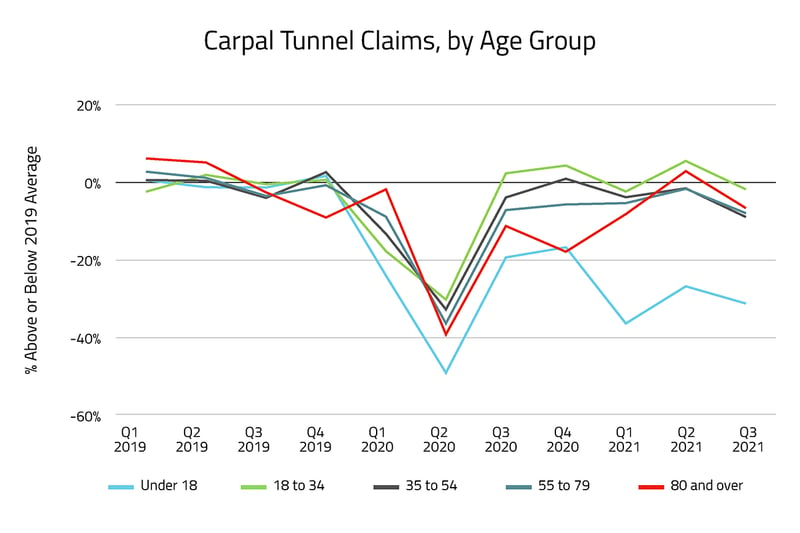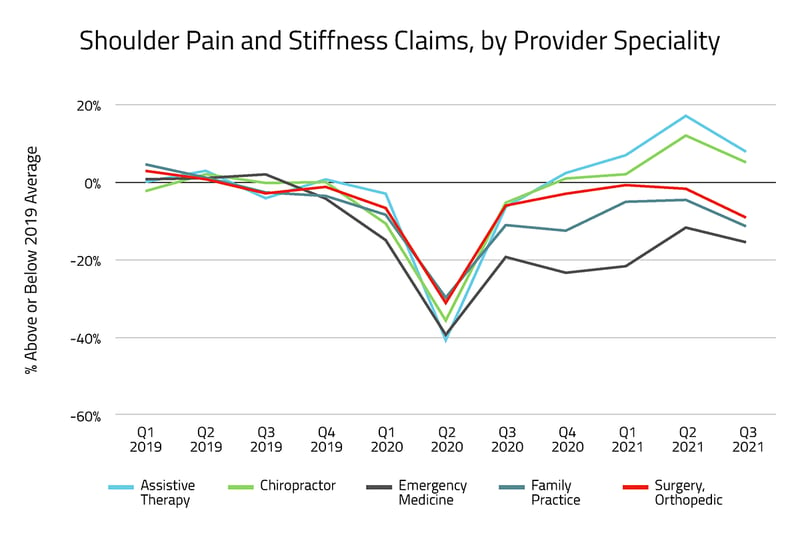Ergonomics, Smergonomics: Work-from-Home Trend Has Minimal Effect on Common Injuries Experienced by Remote Workers

Last week, many of us hit our two-year anniversaries of working from home, and while several companies have started to welcome workers back into the office, many say they will keep remote work in place for the foreseeable future. A growing chorus of health and wellness experts, chiropractors, and ergonomics specialists have warned along the way that the professional sector’s mass decampment to spare bedrooms and makeshift dining room offices has the potential to create a big problem for workplace health.
In September 2020, an American Chiropractic Association survey found 92% of chiropractors reported an increase in neck pain, back pain, and other musculoskeletal issues during the pandemic. Workers' Compensation specialists braced for a surge in claims stemming from inadequate home office set-ups. A year later, Mary Nasenbenny, Chief Claims Officer at The Hartford, told the Hartford Courant that she expected a rise in claims “because people were sitting at their couches without the proper keyboard, without the proper chair height.”
The steady build up of concern, set against the backdrop of a largely positive response to the experience of remote work, raises the question: Is working from home really as dangerous as people are saying?
To find out, we dug into Komodo’s Healthcare Map™ — the industry’s largest and most complete database of de-identified, real-world patient data — to analyze trends in healthcare encounters for common conditions related to office work and improper desk posture: neck and back pain, shoulder pain and stiffness, computer elbow, carpal tunnel syndrome, and computer vision syndrome. Tracking the frequency of these issues from January 2019 through September 2021, we found no significant increases in claims to support the theory that working from home is a looming health hazard.
Here are the details:
No Significant Increase Seen in Work-from-Home Injury Claims Throughout Pandemic
Looking at encounters by age, we observed a steep decline in all claims during the lockdown period of the pandemic, which rebounded somewhat in the fall of 2020. We anticipated a more significant rebound, to reflect the physical impacts of the work-from-home trend, and of visits that might have been scheduled to make up for those missed during lockdown, but we saw no evidence of either. Claims remained lower than the pre-pandemic baseline for most of the time period we examined.

As shown in the chart above, which tracks claims related to carpal tunnel syndrome by age group, the only cohorts to see a slight increase in encounters following the lockdown period were those ages 18–34 and those aged 80 and older, who experienced a 5.6% and 3.0% increase, respectively, above the 2019 average for the same time period.
A similar pattern was observed in claims for neck and back pain, shoulder pain and stiffness, and computer elbow. In all three cases, we saw a consistent trend of sharply reduced claims between Q1 and Q3 of 2020, followed by a gradual return to pre-pandemic volumes for most age groups, with the exception of the under 18 population, which remained low throughout the pandemic.
The one area that showed a significant variation from this trend was in claims related to computer vision syndrome, which is a group of eye- and vision-related problems that result from prolonged screen time. Healthcare encounters related to computer vision syndrome were notably lower than historical average across all age groups during the lock-down period, and they stayed significantly lower through the period following lockdown.
Brief Surge in Chiropractic and Assistive Therapy Claims in Spring of ‘21
But what about all of those chiropractors who reported an increase in patient complaints of aches and pains from prolonged periods hunched over at home workstations? We also segmented the results of our analysis by provider type to see what kinds of care people sought and whether or not any specific specialties had an influx of patients.
In fact, we did find an increase in visits to the chiropractor, but it did not occur during the height of the pandemic. In Q2 of 2021, chiropractic encounters for shoulder pain and stiffness increased 12.2% above the 2019 average, and visits for neck and back pain rose 7.4%. Likewise, assistive therapy providers saw a 17.3% increase in shoulder pain and stiffness visits and a 12.3% increase in neck and back pain visits during the same period. These rebounds in volume slightly lessened in Q3 of 2021 but remained above the pre-pandemic baseline.

Ultimately, these findings highlight the agility of office workers and their employers who’ve managed a massive shift away from conventional work environments without a corresponding surge in injuries as was predicted by so many experts. Whether it’s the result of less time commuting, money spent on high-quality home office furniture, or just the added flexibility that remote work provides, most remote working professionals have come through the last two years without tweaked necks or blurry eyes. It is possible that a number of workers may have ongoingly deferred medical care for less severe conditions throughout the pandemic. As the work-from-home trend continues, it will be important to keep tracking the longer-term trends in the public health impacts of remote work, to inform workplace policies, and to protect employees from harm.
Interested in other reports on how the pandemic has impacted health? Read Komodo’s analysis,  .
.
To see more articles like this, follow Komodo Health on Twitter and LinkedIn, and visit Insights on our website.




